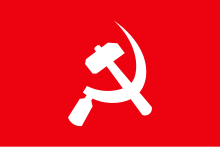Communist Party of India (Marxist-Leninist) Liberation
The Communist Party of India (Marxist-Leninist) Liberation ( CPI (ML) L , Hindi भारतीय कम्युनिस्ट पार्टी (मार्क्सवादी-लेनिनवादी) लिबरेशन ) is one of the communist parties in India .
history
In 1969 a dissident group split off from the Communist Party of India (Marxist) (CPM) under the name Communist Party of India (Marxist-Leninist) (CPI (ML)). The dissident group refused to take part in regular elections as practiced by the CPM and called for an active revolutionary struggle along the lines of the Bolsheviks under Lenin . One impetus for the foundation was a peasant uprising in the town of Naxalbari in the Darjeeling district in West Bengal in 1967, which later expanded into a more comprehensive social revolutionary movement, the " Naxalites ". In the years after its founding, the CPI (ML) tried to bring about a revolutionary state of affairs through terrorist actions against state institutions and alleged "class enemies". The actions were essentially limited to the states of Uttar Pradesh , Bihar , West Bengal and northern Andhra Pradesh . However, its effect remained regionally limited and the CPI (ML) was persecuted by the state as a terrorist group. The city of Calcutta became a focus of their activities .
In the CPI (ML) there was increasing ideological and sectarian wing fighting. In 1971 the CPI (ML) split into a wing under Satyanarayan Singh and a wing under Charu Majumdar . The Majumdar faction subsequently fell out over their position on the Lin Biao case . From the anti-Lin Biao faction, the Communist Party of India (Marxist-Leninist) Liberation (CPI (ML) L) emerged later in 1974 .
During the period of the state of emergency from 1975 to 1977 , the CPI (ML) L, like all other communist organizations, was hit by increased state repression and many of its leaders were imprisoned. After 1977 the party adopted more moderate positions and revised its original refusal to participate in processes within the established social structures. One reason for this change of heart was possibly the visit of party chairman Vinod Mishra to the People's Republic of China in 1979, where Deng Xiaoping had just started his major reform work. The party decided not to take part in elections itself, but to found "mass organizations" that should serve as a lever for the implementation of its political goals. Accordingly, the Indian People's Front (IPF) was founded in April 1982 . The IPF took part in elections and won several mandates, such as B. in the Indian parliamentary elections in 1989 the constituency 36-Arrah in Bihar. Another mass organization of the CPI (ML) L was the People's Democratic Front (PDF, "People's Democratic Front") founded in 1985 in the Karbi Anglong district in Assam , which was renamed the Autonomous State Demand Committee (ASDC) in the following year . The ASDC wanted to take advantage of the dissatisfaction of the tribal population of Assam and channel them into revolutionary channels. In the mid-1990s, the CPI (ML) L decided to give up its abstinence from elections entirely. In 1994 the IPF was therefore dissolved again and from the 1996 election the CPI (ML) L openly ran for parliamentary elections. However, you could only win a mandate once in all-India elections, namely in the 1999 election in the constituency 3-Autonomous District in Assam, so to speak in the succession of the ASDC.
Today the party is largely without political influence. In the 2014 general election , however, the party still received more than 1 million votes nationwide.
Web links
- Website of the CPI (ML) L (English)
Individual evidence
- ↑ a b Arindam Sen: A Lesson In Dynamism And Dedication. (No longer available online.) CPI (ML) L website, archived from the original on 23 September 2015 ; accessed on August 15, 2015 .
- ↑ a b c Election Results - Full Statistical Reports. Indian Election Commission, accessed on October 3, 2014 (English, election results of all Indian elections to the Lok Sabha and the parliaments of the states since independence).
